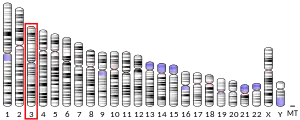FANCD2OS
Fanconi Anemia Opposite Strand Transcript protein is a predicted protein that in humans is encoded by the FANCD2OS gene.[5] The name is derived from mRNA transcribed from the strand complementary to the FANCD2 gene.
| FANCD2OS | |||||||||||||||||||||||||||||||||||||||||||||||||||
|---|---|---|---|---|---|---|---|---|---|---|---|---|---|---|---|---|---|---|---|---|---|---|---|---|---|---|---|---|---|---|---|---|---|---|---|---|---|---|---|---|---|---|---|---|---|---|---|---|---|---|---|
| Identifiers | |||||||||||||||||||||||||||||||||||||||||||||||||||
| Aliases | FANCD2OS, C3orf24, FANCD2 opposite strand | ||||||||||||||||||||||||||||||||||||||||||||||||||
| External IDs | MGI: 1918229 HomoloGene: 45456 GeneCards: FANCD2OS | ||||||||||||||||||||||||||||||||||||||||||||||||||
| |||||||||||||||||||||||||||||||||||||||||||||||||||
| |||||||||||||||||||||||||||||||||||||||||||||||||||
| |||||||||||||||||||||||||||||||||||||||||||||||||||
| |||||||||||||||||||||||||||||||||||||||||||||||||||
| Wikidata | |||||||||||||||||||||||||||||||||||||||||||||||||||
| |||||||||||||||||||||||||||||||||||||||||||||||||||
Gene
The gene is encoded on Chromosome 3 (human) at p25.3 on the minus strand from 10081320-10108339nt. The primary transcript is 1105nt which codes for a protein of 177 amino acid in length.[6] The gene on the strand complementary to FANCD2 located 5' from CYCSP11 and 3’ from BRK1 and VHL genes.[5]
mRNA
There are six alternatively spliced transcripts with differences in the 5' and 3' ends as well changes in exon usage.[7] The most common isoform is 1105 bp.[8]
Promoter Region
The promoter region predicted by the Genomatix El Dorado algorithm spans from 10108742-10108009 bp. Promoters are associated with a wide variety of tissues including B-lymphocytes, germ cells, muscle, neurons & prostate.
Evolutionary History
Protein sequence
The protein from the longest transcript is 177AA in length with a mass of 20188.59kD. The protein consists of a domain of unknown function from the DUF4563 superfamily.[10]
Orthologs
Orthologs of FANCD2OS exist throughout mammals, reptiles, birds and in the cartilaginous fish Australian ghostshark.[11] The protein sequence undergoes mutation at a rate similar to the blood protein fibrinogen.
| Species | Common name | NCBI accession | Identity | similarity | E-value |
|---|---|---|---|---|---|
| Pongo abelii | Sumatran orangutan | XP_003776240.1 | 98.9 | 99.4 | 1.21E-133 |
| Cricetulus griseus | Chinese hamster | XP_003511850.1 | 73.6 | 80.9 | 1.56E-95 |
| Ovis aries | Sheep | XP_004018322.1 | 97.2 | 98.3 | 6.79E-131 |
| Leptonychotes weddellii | Weddell seal | XP_006739055.1 | 96.6 | 98.3 | 5.13E-130 |
| Condylura cristata | Star-nosed mole | XP_004692437.1 | 91.0 | 95.5 | 3.01E-123 |
| Orcinus orca | Killer whale | XP_004286877.2 | 88.1 | 92.3 | 1.05E-90 |
| Trichechus manatus latirostris | Florida manatee | XP_004368376.1 | 96.6 | 98.9 | 9.95E-131 |
| Alligator mississippiensis | American alligator | XP_014457972.1 | 69.3 | 88.6 | 1.40E-48 |
| Chrysemys picta bellii | Painted turtle | XP_005307285.1 | 58.3 | 75 | 2.18E-78 |
| Gekko japonicus | Schlegel's Japanese gecko | XP_015261231.1 | 56.5 | 72.3 | 4.39E-74 |
| Thamnophis sirtalis | Common garter snake | XP_013914711.1 | 55.9 | 69.5 | 2.75E-69 |
| Xenopus laevis | African clawed frog | NP_001088778.1 | 55.4 | 71.2 | 1.98E-68 |
| Xenopus tropicalis | Western clawed frog | NP_001090717.1 | 52 | 71.2 | 3.57E-65 |
| Callorhinchus milii | Australian ghostshark | XP_007888744.1 | 39.9 | 56.8 | 5.67E-43 |
Paralogs
FANCD2OS has no known paralogs in Homo sapiens.
References
- GRCh38: Ensembl release 89: ENSG00000163705 - Ensembl, May 2017
- GRCm38: Ensembl release 89: ENSMUSG00000033963 - Ensembl, May 2017
- "Human PubMed Reference:". National Center for Biotechnology Information, U.S. National Library of Medicine.
- "Mouse PubMed Reference:". National Center for Biotechnology Information, U.S. National Library of Medicine.
- "Entrez Gene - FANCD2OS FANCD2 opposite strand Homo sapiens". Retrieved 6 February 2016.
- "FANCD2 opposite strand protein". NCBI. Retrieved 2 May 2016.
- "AceView C3orf24". NCBI. Retrieved 2 May 2016.
- "Homo sapiens FANCD2 opposite strand (FANCD2OS), transcript variant 1, mRNA". NCBI Nucleotide. NCBI. Retrieved 19 April 2016.
- "NCBI - GDS592 / gnf1m17159_at / Fancd2os". NCBI. Retrieved 15 Mar 2016.
- "Conserved Protein Domain Family DUF4563". NCBI. Retrieved 2 May 2016.
- "Homologene: FANCD2OS". Retrieved 6 February 2016.



